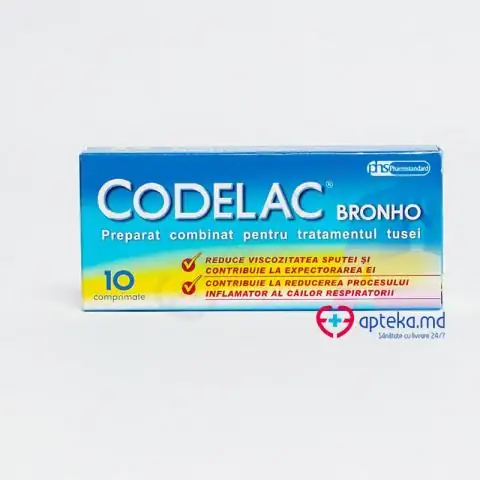- Author Rachel Wainwright [email protected].
- Public 2023-12-15 07:39.
- Last modified 2025-11-02 20:14.
Butamirat
Butamirate: instructions for use and reviews
- 1. Release form and composition
- 2. Pharmacological properties
- 3. Indications for use
- 4. Contraindications
- 5. Method of application and dosage
- 6. Side effects
- 7. Overdose
- 8. Special instructions
- 9. Application during pregnancy and lactation
- 10. Use in childhood
- 11. For violations of liver function
- 12. Drug interactions
- 13. Analogs
- 14. Terms and conditions of storage
- 15. Terms of dispensing from pharmacies
- 16. Reviews
- 17. Price in pharmacies
Latin name: Butamirate
ATX code: R05DB13
Active ingredient: butamirate (Butamirate)
Manufacturer: JSC Sintez (Russia)
Description and photo update: 2020-16-06

Butamirate is a centrally acting antitussive drug.
Release form and composition
The drug is produced in the form of a syrup: a clear liquid, colorless or with a yellow tint, has a vanilla smell (100 ml in orange glass bottles, in a cardboard box 1 bottle complete with a dosage spoon or without it, as well as instructions for the use of Butamirat).
100 ml of syrup contains:
- active substance: butamirate citrate - 0.15 g;
- auxiliary components: ethanol (rectified ethyl alcohol), glycerol (glycerin), sorbitol, benzoic acid, sodium saccharinate dihydrate, sodium hydroxide solution 30%, vanillin, purified water.
Pharmacological properties
Pharmacodynamics
Butamirate is a centrally acting antitussive drug. Its active substance, butamirate, has a direct effect on the cough center, which causes the suppression of cough. Shows a bronchodilating effect, promotes the expansion of the bronchi, improves spirometry indicators (lowering airway resistance) and oxygenation of the blood (blood oxygenation), and facilitates breathing.
Butamirate neither chemically nor pharmacologically refers to the alkaloids of opium, does not cause the formation of dependence and addiction.
Pharmacokinetics
After oral administration, butamirate is rapidly and completely absorbed in the gastrointestinal tract. While taking doses of 22.5; 45; Its measured concentrations of 67.5 and 90 mg are determined in the blood after 5-10 minutes. The maximum concentration (C max) in the blood plasma is achieved within 1 hour, when a dose of 90 mg is taken orally, it averages 16.1 ng / ml.
The effect of food on the absorption of butamirate has not been established.
The available data suggest that butamirate ester is rapidly and completely absorbed and hydrolyzed in plasma to form 2-phenylbutyric acid and diethylaminoethoxyethanol.
The mean plasma concentration of 2-phenylbutyric acid is achieved within 1.5 hours and dietilaminoetoksietanola -. 0.67 hours after administration of the drug at a dose of 90 mg C max of 2-phenylbutyric acid was 3052 ng / ml, dietilaminoetoksietanola - 160 ng / ml.
In the dose range from 22.5 to 90 mg, the level of 2-phenylbutyric acid and diethylaminoethoxyethanol changes in proportion to the size of the dose taken.
The volume of distribution is from 81 to 112 liters.
Plasma protein binding of 2-phenylbutyric acid is 89.3-91.6%, diethylaminoethoxyethanol - 28.8-45.7%.
The penetration of butamirate through the placenta and its excretion in breast milk has not been studied.
Butamirate is metabolized very quickly as a result of hydrolysis with the formation of 2-phenylbutyric acid and diethylaminoethoxyethanol, which have an antitussive effect. By hydroxylation in the para-position, 2-phenylbutyric acid undergoes further partial metabolism. After conjugation in the liver, acidic metabolites are largely bound to glucuronic acid.
Excretion of metabolites occurs mainly through the kidneys. Conjugates of 2-phenylbutyric acid in urine are determined in higher concentrations than in blood plasma. In urine, butamirate is detected within 48 hours. After taking the drug at a dose of 22.5; 45; 67.5 and 90 mg, when sampling for 96 hours, the share of butamirate excreted in urine is approximately 0.02; 0.02; 0.03 and 0.03% of the dose taken, respectively.
In percentage terms, diethylaminoethoxyethanol is excreted in the urine in a larger amount, compared with the excretion of unconjugated 2-phenylbutyric acid or butamirate in unchanged form.
The half-life (T 1/2) of butamirate is 1.48-1.93 hours, 2-phenylbutyric acid is 23.26-24.42 hours, diethylaminoethoxyethanol is 2.27-2.9 hours.
Indications for use
The use of Butamirat is indicated for the treatment of dry coughs of various etiologies, including whooping cough.
In addition, the drug is taken to suppress cough during surgery and bronchoscopy, in the preoperative and postoperative periods.
Contraindications
Absolute:
- intolerance to fructose;
- I trimester of pregnancy;
- breast-feeding;
- age up to 3 years;
- hypersensitivity to the components of the drug.
Butamirat should be taken with caution in the II and III trimesters of pregnancy, with alcoholism, liver diseases, epilepsy, brain diseases, the patient's tendency to develop drug dependence, in children over the age of 3 years.
Butamirate, instructions for use: method and dosage
Butamirate syrup is taken orally, before meals.
If the package is not equipped with a dosing spoon, then the procedure should be carried out using a teaspoon. The attached dosage spoon or 1 teaspoon contains 5 ml of the drug.
The recommended dosage has the following age restrictions:
- children: aged 3-6 years - 5 ml 3 times a day, 6-12 years old - 10 ml 3 times a day, 12 years and older - 15 ml 3 times a day;
- adults: 15 ml 4 times a day.
The duration of the course of treatment without consulting a doctor is 7 days. If the cough persists for more than 7 days, you should see a doctor.
Side effects
- from the nervous system: rarely (≥ 1/10 000, <1/1000) - dizziness, drowsiness;
- from the digestive system: rarely - diarrhea, nausea;
- on the part of the skin and subcutaneous tissues: rarely - urticaria;
- others: the frequency has not been established (there is insufficient reliable data to determine the incidence of adverse events) - allergic reactions.
Overdose
Symptoms: abdominal pain, nausea, vomiting, diarrhea, dizziness, drowsiness, irritability. In addition, the patient may experience a decrease in blood pressure, impaired coordination of movements.
There is no specific antidote, so symptomatic therapy is used. Shows immediate gastric lavage, ingestion of activated charcoal, laxatives. If necessary, measures are taken to maintain the function of the respiratory and cardiovascular systems.
special instructions
Butamirate syrup can be used to treat patients with diabetes mellitus, since sodium saccharinate and sorbitol are used as sweeteners in its composition.
With the development of dizziness, it is necessary to reduce the dose of the drug or stop taking it.
The simultaneous use of alcoholic beverages is contraindicated.
Influence on the ability to drive vehicles and complex mechanisms
During the period of drug treatment, patients should not engage in potentially hazardous activities that require the speed of psychomotor reactions and increased concentration of attention, including the management of vehicles and complex mechanisms.
Application during pregnancy and lactation
The use of Butamirat is contraindicated in the first trimester of pregnancy and during breastfeeding.
With caution and only on the recommendation of a doctor, it is allowed to take syrup in the II and III trimesters of the gestation period.
Pediatric use
The appointment of Butamirat is contraindicated for children under the age of 3 years.
With caution, Butamirat should be given to children over 3 years old, it is recommended to consult a doctor first.
For violations of liver function
Butamirat should be used with caution in patients with liver disease.
Drug interactions
You can not take the syrup at the same time with any drugs that have a depressing effect on the central nervous system (including ethanol-containing drugs for oral administration, sleeping pills, antipsychotics and tranquilizers).
It is recommended to avoid combination with expectorant drugs in order to prevent the development of bronchospasm and respiratory tract infection against the background of accumulation of phlegm in the respiratory system.
Analogs
Butamirat's analogues are Ambrobene Stopussin, Codelac Neo, Omnitus, Stoptussin, Panatus, Panatus Forte, Sinekod, Tussikod, Pharmacod, etc.
Terms and conditions of storage
Keep out of the reach of children.
Store at temperatures up to 25 ° C.
The shelf life is 3 years.
Terms of dispensing from pharmacies
Available without a prescription.
Reviews about Butamirat
There are no reviews about Butamirate on the Internet, but there are user opinions about similar preparations containing citrate butamirate as an active ingredient. Patients respond positively to these antitussives, claiming their ease of use, affordable cost, and high efficiency in the fight against dry cough. Many products taste good, which makes them easier to use in young children. The development of side effects is reported very rarely, nevertheless, it is still advised to take such drugs as prescribed by a doctor and strictly follow the dosage recommendations indicated in the instructions.
Price for Butamirat in pharmacies
Due to the lack of the drug in the pharmacy chain, the price of Butamirat is unknown. The cost of analogs is: Codelac Neo, syrup, in the package 1 bottle of 100 ml - from 227 rubles; Omnitus, syrup, in the package 1 bottle of 200 ml - from 246 rubles; Sinekod, drops for children, in the package 1 bottle of 20 ml - from 378 rubles.

Anna Kozlova Medical journalist About the author
Education: Rostov State Medical University, specialty "General Medicine".
Information about the drug is generalized, provided for informational purposes only and does not replace the official instructions. Self-medication is hazardous to health!






